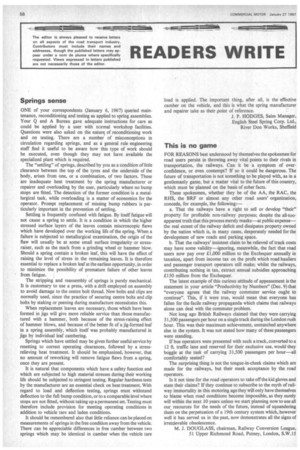READERS WRITE
Page 60

If you've noticed an error in this article please click here to report it so we can fix it.
Springs sense
ONE of your correspondents (January 6, 1967) queried maintenance, reconditioning and testing as applied to spring assemblies. Your Q and A Bureau gave adequate instructions for care as could be applied by a user with normal workshop facilities. Questions were also asked on the nature of reconditioning work and on testing. There are a number of misconceptions in circulation regarding springs, and as a general rule engineering staff find it useful to be aware how this type of work should be executed, even though they may not have available the specialized plant which is required.
The "settling" of springs, described by you as a condition of little clearance between the top of the tyres and the underside of the body, arises from one, or a combination, of two factors. These are inadequate heat treatment by the spring manufacturer or repairer and overloading by the user, particularly where no bump stops are fitted. The detection of the former condition is a metallurgical task, while overloading is a matter of economics for the operator. Prompt replacement of missing bump rubbers is particularly important in the prevention of settling.
Settling is frequently confused with fatigue. By itself fatigue will not cause a spring to settle. It is a condition in which the higher stressed surface layers of the leaves contain miscroscopic flaws which have developed over the working life of the spring. When a failure is subjected to metallurgical examination, the origin of the flaw will usually be at some small surface irregularity or stressraiser, such as the mark from a grinding wheel or hammer blow. Should a spring contain a broken leaf, this will have the effect of raising the level of stress in the remaining leaves. It is therefore essential to replace a broken leaf at the earliest opportunity, in order to minimize the possibility of premature failure of other leaves from fatigue.
The stripping and reassembly of springs is purely mechanical. It is customary to use a press, with a drift employed on assembly to avoid damage to the centre bolt thread. New bolts and clips are normally used, since the practice of securing centre bolts and clip bolts by staking or peening during manufacture necessitates this.
When replacement leaves are necessary, those which have been formed in jigs will give more reliable service than those manufactured with a hammer, both because of the stress-raising effect of hammer blows, and because of the better fit of a jig-formed leaf in a spring assembly, which itself was probably manufactured in jigs by individual leaf cambering.
Springs which have settled may be given further useful service by resetting to correct operating clearances, followed by a stressrelieving heat treatment. It should be emphasized, however, that no amount of reworking will remove fatigue flaws from a spring, once they are present.
It is natural that components which have a safety function and which are subjected to high material stresses during their working life should be subjected to stringent testing. Regular hardness tests by the manufacturer are an essential check on heat treatment. With regard to load and deflection testing, springs must withstand deflection to the fill bump condition, or to a comparable level where stops are not fitted, without taking up a permanent set. Testing must therefore include provision for meeting operating conditions in addition to vehicle tare and laden conditions.
It should be remembered also that little reliance can be placed on measurements of springs in the free condition away from the vehicle. There can be appreciable differences in free camber between two springs which may be identical in camber when the vehicle tare load is applied. The important thing, after all, is the effective camber on the vehicle, and this is what the spring manufacturer and repairer take as their .point of reference.
J. P. HODGES, Sales Manager, English Steel Spring Corp. Ltd., River Don Works, Sheffield












































































































